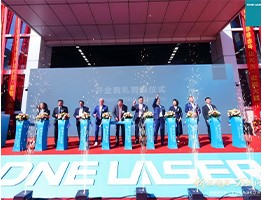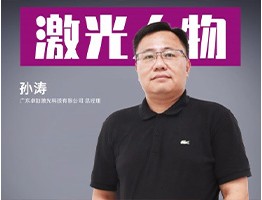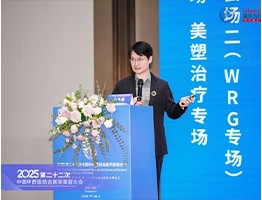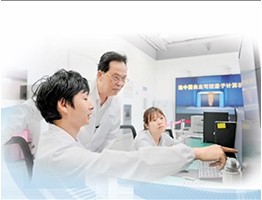Shi Lei (Hipa Tech): Focus on Domestic Substitution, Future Layout in High-End Laser Micromachining
source:Laser Manufacture News
keywords:
Time:2025-11-21
Source: Laser Manufacture News 8th Nov 2025
Currently, China's manufacturing industry is accelerating its transformation and upgrading, and the demand for high-end laser micromachining equipment in key fields such as PCB, semiconductors, and new energy is growing increasingly robust. However, for a long time, the market in this field has been mostly monopolized by foreign brands, making domestic substitution one of the core demands of the industry's development. Against this industry backdrop, Dongguan Hipa Technology Co., Ltd., founded in 2021, has emerged as a dark horse. In just a few years, it has achieved breakthrough progress in technological R&D and industrial application, and its products have been successfully recognized by leading enterprises such as Kingwong Electronics and Shennan Circuits.
"Looking to the future, we will adhere to the development philosophy of 'deepening and expanding'. While continuing to deepen our presence in existing fields, we will actively expand domestic and international markets to achieve all-round development." Recently, editors from Laser Manufacture News had the privilege of interviewing Shi Lei, General Manager of Hipa Technology, to hear him share the company's development code, technological layout, and profound insights into the industry's future.

Shi Lei, General Manager of Dongguan Hipa Technology Co., Ltd.
Laser Manufacture News: Hello, Mr. Shi. Thank you very much for accepting our interview. As a leading high-tech startup specializing in high-end laser micromachining equipment in China, what breakthrough progress has Hipa Technology made in technological R&D and industrial application since its establishment?
Mr. Shi: Hello, thank you to Laser Manufacture News for your attention to Hipa Technology. Since the company was founded in 2021, we have always focused on the in-depth integration of technological R&D and industrial implementation, and we have indeed accumulated some achievements over the past two years. In terms of technological R&D, our core breakthrough lies in the independent development of a number of laser micromachining equipment with independent intellectual property rights. For example, the UV high-speed drilling machine (model HP-D-UV1000) specially designed for FPCB boards supports multiple processing technologies, adopts independently developed software, and features automatic power reading and calibration, built-in automatic energy monitoring, and other functions to ensure processing stability and accuracy. There is also the Error Mark marking system (model HP-M-GR1100), with a laser marking speed of up to 1000mm/s and a jump speed of 9000mm/s. Equipped with a linear motor transmission system, it also supports various functions such as automatic energy measurement and calibration, and is easy to operate. In terms of patents, we have accumulated 23 patents and 5 software copyrights in a short period of time, which is a direct proof of our R&D strength.
In terms of industrial application, Hipa Technology's products have been adopted and recognized by some leading domestic PCB manufacturers. Our UV laser drilling machines, IC carrier board marking machines, laser ceramic drilling machines and other equipment have attracted the attention of more PCB, semiconductor, and leading customers by continuously optimizing product performance and improving service quality. Our main customer base includes Kinwong Electronics, Shennan Circuits, HonFlex Electronics, etc.
More importantly, we have always aimed to promote the domestic substitution of high-end laser micromachining equipment. At present, the product technology has reached the level of similar imported high-end laser equipment, providing domestic customers with a more cost-effective choice and breaking the monopoly of foreign brands in this field to a certain extent.
Laser Manufacture News: You just mentioned that your company's UV laser drilling machines, IC carrier board marking machines, laser ceramic drilling machines and other equipment have been recognized by leading domestic manufacturers. Could you please elaborate on the specific advantages of these products in terms of precision, efficiency, and process adaptability?
Mr. Shi: That's right. Precision, efficiency, and process adaptability are precisely the core competitiveness of our products. Let's start with the UV laser drilling machine. We have invested tremendous efforts in its precision. This equipment adopts independently developed software and supports automatic power reading and calibration functions to ensure processing stability; it is equipped with a built-in automatic energy monitoring system that can conduct real-time monitoring of pulse energy, guaranteeing the energy precision of each drill hole; the equipment also features a processing playback inspection function and a pre-view function, which can detect potential issues in advance and make adjustments, thereby improving processing precision and reliability. In terms of efficiency, this equipment is specially designed for FPCB boards, supporting multiple processing technologies such as PTH, BVH, and CUTTING. It is suitable for micro-hole processing of single-layer and double-layer boards, with a drilling efficiency of up to 300 holes per second. It can quickly complete different types of drilling tasks and enhance production efficiency.
As for the IC carrier board marking machine, precision is the key requirement for such products. Similar products on the market are usually equipped with a high-definition CCD visual positioning system to achieve high-precision marking. Haipo Technology's IC carrier board marking machine adopts high-precision visual line scan positioning technology, which can accurately control the marking position, ensuring that the marked text, patterns, etc., are clear, accurate, and have high positional accuracy. In the future, we will continue to optimize the performance of these products to further amplify these advantages.
Laser Manufacture News: As a startup, Hipa Technology has chosen to deepen its presence in precision machining niche segments such as PCB, semiconductors, and new energy. What were the considerations behind this strategic layout? And which tracks will you focus on in the future?
Mr. Shi: This strategic layout is mainly based on three considerations. First, market demand. The PCB, semiconductor, and new energy industries are developing rapidly, with a continuous increase in demand for precision machining equipment. A large number of laser equipment in laser applications still need to be imported, and based on this, Hipa Technology has invested heavily in R&D to pursue domestic substitution. Second, alignment with technical advantages. Core members of our team are all industry elites with more than 10 years of experience in well-known domestic and foreign laser equipment manufacturing companies. They have rich experience and profound technical accumulation in laser micromachining technology, and are capable of developing high-performance equipment that meets the needs of these industries. Third, opportunities for domestic substitution. For a long time, high-end laser micromachining equipment has been monopolized by foreign brands. With the transformation and upgrading of domestic manufacturing, the demand for domestic substitution has become increasingly urgent. Hipa Technology aims to promote the domestic substitution of high-end laser micromachining equipment, and with its technical advantages and product performance, it has the opportunity to achieve domestic substitution in these fields and seize market share.
Regarding future layout, we will adhere to the philosophy of "deepening and expanding". On the one hand, we will continue to deepen our presence in existing fields. Centering on laser application scenarios in the PCB, semiconductor, and new energy industries, we will continuously launch new products and technologies, improve equipment performance and quality, and meet the evolving needs of customers. For example, in the PCB industry, we will further optimize the performance of the Error Mark marking system and UV high-speed drilling machine; in the semiconductor industry, we will develop laser micromachining equipment more suitable for chip manufacturing. On the other hand, we will expand domestic and international markets. While consolidating our leading position in the domestic market, we will actively explore the international market and enhance the brand's international influence. Through participating in international exhibitions, technical exchange meetings and other activities, we will showcase our technical strength and product advantages to attract more overseas customers and partners.
Laser Manufacture News: Currently, laser processing equipment is deeply integrating with AI, machine vision, and industrial IoT. Hipa Technology's independently developed HP-D-UV1000 drilling machine already has intelligent functions such as automatic energy monitoring. What specific plans does the company have for the intelligent upgrading of its products in the future?
Mr. Shi: Intelligence is indeed an important development direction for laser processing equipment. We already have a preliminary foundation for intelligent functions, and will increase investment in this direction in the future, with two core plans:
First, intelligent parameter optimization. Drawing on the experience of Huagong Technology in establishing an AI research laboratory to achieve intelligent parameter optimization through an AI platform, Hipa Technology may use artificial intelligence algorithms to automatically optimize laser processing parameters such as laser power, frequency, and scanning speed based on factors such as different processing materials and process requirements, so as to achieve the best processing results.
Second, fault diagnosis and prediction. We will adopt algorithms such as machine learning and deep learning to conduct real-time monitoring and analysis of equipment operating data, enabling intelligent diagnosis and prediction of equipment faults. For example, by analyzing equipment parameters such as vibration, temperature, and current, potential fault hazards can be detected in advance, and early warnings can be issued in a timely manner for preventive maintenance, thereby improving equipment reliability and stability.
Laser Manufacture News: The global laser processing market is highly competitive. Compared with international giants and domestic peers, in what aspects do Hipa Technology's core technical advantages and differentiated competitiveness manifest?
Mr. Shi: Compared with fellow companies, our core advantages and competitiveness are mainly reflected in the following three aspects: First, focus on specific application scenarios. We have not blindly pursued full coverage of product lines; instead, we focus on developing products tailored to laser application scenarios in the PCB, integrated circuit, and new energy industries, dedicated to providing high-intelligence, high-precision, and high-automation laser micromachining equipment for these specific fields. Compared with international giants and domestic peers, we have a deeper understanding of customer needs in these areas and can provide more targeted solutions.
Second, the positioning advantage of domestic substitution. With the goal of promoting the domestic substitution of high-end laser micromachining equipment, our products may have a more competitive price compared with international giants, while we can provide domestic customers with more timely and high-quality localized services. Under the general trend of domestic substitution, it is easier for us to gain recognition and support from domestic customers.
In addition, customized service capabilities are another major advantage of ours. We attach great importance to personalized design and optimization according to customers' specific needs, which can well meet the differentiated needs of different customers and enhance customer stickiness.
Laser Manufacture News: As a technology-driven enterprise, what systematic measures has Hipa Technology taken in the introduction, training, and team building of core R&D talents? How to ensure the sustainability of technological R&D?
Mr. Shi: Talents are our most core asset, and we have established a systematic mechanism of "attract, cultivate, retain, and utilize". In terms of talent introduction, according to the R&D needs of laser application scenarios in the PCB, integrated circuit, and new energy industries, we formulate detailed job descriptions, clarify employment requirements and skill needs, and regularly assess team skill gaps to determine recruitment priorities. We also adopt diversified channels: in addition to extensively attracting talents through various channels such as online recruitment platforms, social media, campus recruitment, and headhunting recommendations, we also participate in industry technical seminars, exhibitions, and other activities to tap potential senior talents.
In terms of team building, we have set up core management positions such as R&D Director and Technical Manager, responsible for overall R&D planning and resource coordination. We have also established professional technical teams including software R&D, hardware R&D, and testing, as well as a technical support team and a Project Management Office (PMO) to provide guarantees, with clear powers and responsibilities. For talent cultivation, we have established an internal knowledge base, encouraging team members to organize project experience and technical insights into documents for uploading and sharing to achieve knowledge inheritance. At the same time, we encourage team members to participate in industry conferences and technical exchange activities to keep abreast of industry technical trends and development directions, ensuring that the company's technological R&D direction is aligned with market demand and industry development trends.
Regarding the sustainability of R&D: On the one hand, we will continue to increase R&D investment. For example, we launched the first round of financing in 2023 to ensure sufficient funds to support technological R&D and innovation. On the other hand, we will strengthen industry-university-research cooperation, collaborating with universities and research institutions to jointly carry out technical R&D projects, leveraging the scientific research strength and innovative resources of universities and research institutions to improve the company's technological R&D level. In addition, we will closely follow industry technical trends to ensure that the R&D direction is in line with market demand, avoiding R&D being divorced from reality.
Laser Manufacture News: Looking ahead to the next 3-5 years, what are Hipa Technology's strategic goals and development plans? What specific goals and initiatives do you have in terms of technological innovation, market expansion, and industrial cooperation?
Mr. Shi: Our core strategic goal is to promote the domestic substitution of high-end laser micromachining equipment and become a leading enterprise in this field. Through continuous R&D investment and technological innovation, we will provide higher-quality and brand-new technical solutions for industries such as PCB, semiconductors, and new energy, break the monopoly of foreign similar products, and help China's advanced manufacturing sector develop to a higher level.
In terms of technological innovation, the goal is to continuously improve the technical level of laser micromachining equipment, maintain the product characteristics of "high intelligence, high precision, and high automation," and enhance product competitiveness. Regarding initiatives, we will continue to increase R&D investment. Relying on our experienced R&D team, we will continuously conduct technological R&D and innovation around application scenarios in core industries, optimize existing products, and improve equipment performance and stability.
In terms of market expansion, the goal is to expand market share, increase penetration among domestic leading customers, and gradually explore the international market. Currently, Hipa Technology's products have been adopted and recognized by some leading domestic PCB manufacturers. In the future, the company will continue to strengthen cooperation with existing customers, gain an in-depth understanding of customer needs, and provide higher-quality products and services. At the same time, we will actively develop new customers, especially in the semiconductor and new energy fields. By participating in industry exhibitions, holding product promotion conferences, and other activities, we will enhance the company's brand awareness and influence. In addition, the company will consider cooperating with domestic and foreign distributors to further expand market coverage.
In terms of industrial cooperation, we will strengthen cooperation with upstream and downstream enterprises in the industrial chain to jointly promote the development of the high-end laser micromachining equipment industry. We will establish strategic cooperative partnerships with enterprises in industries such as PCB, semiconductors, and new energy to jointly carry out technological R&D and product application promotion. For example, cooperating with upstream suppliers of laser components, optical elements, etc., to ensure the quality and supply stability of raw materials; cooperating with downstream electronic product manufacturers to understand market needs and technical trends, and jointly develop laser micromachining equipment suitable for specific application scenarios. In addition, the company will deepen cooperation with universities and research institutions, carry out industry-university-research projects, and improve the company's technological innovation capability and talent training level.
Laser Manufacture News: In your opinion, what "bottleneck" links still exist in core components, software systems, etc., of domestic laser equipment? How should Hipa Technology and industry peers work together to make breakthroughs?
Mr. Shi: Objectively speaking, domestic laser equipment does have some shortcomings in core components and software systems. In terms of core components, the most prominent is semiconductor laser chips. High-performance semiconductor laser chips are heavily dependent on imports. Domestically, continuous efforts are needed in overall chip design, epitaxial growth, wavelength stabilization technology, cavity surface engineering technology, and high polarization technology. In terms of software systems, the development of industrial software such as testing software, nesting software, and service software in the laser field is relatively lagging. There is a lack of high-end industrial software with independent intellectual property rights, and there is a gap with advanced foreign software in terms of functional integrity, performance stability, and compatibility with hardware equipment.
Breaking through these "bottleneck" links cannot be achieved by a single enterprise alone; it requires joint efforts from the industry. First, we need to strengthen technological R&D cooperation. Hipa Technology is willing to establish cooperative relationships with other enterprises, universities, and research institutions in the industry to jointly break through key technologies of core components. By integrating resources from all parties, we can achieve full-chain collaborative innovation and build an independent and controllable technical system. Second, we need to increase R&D investment. Industry peers should continue to increase investment in R&D of core components and software systems, attract and cultivate professional talents, and improve independent innovation capabilities. In addition, an industrial alliance can be established within the industry to jointly address technical barriers and market competition. By sharing technical resources, formulating industry standards, coordinating market prices, and other methods, the competitiveness of the entire industry can be enhanced. Of course, we also hope that the government will increase policy support for the laser equipment industry, such as setting up special R&D funds and providing tax incentives, to encourage enterprises to carry out technological innovation and domestic substitution, and create a favorable policy environment for industrial development.
Laser Manufacture News: Looking ahead to the industry development after 2025, what technical trends do you think will emerge in the field of laser precision micromachining? based on these future trends, what countermeasures and forward-looking layouts does Hipa Technology have?
Mr. Shi: I believe there will be four major technical trends in the field of laser precision micromachining in the future. First, higher precision: the application of cutting-edge technologies such as femtosecond laser processing and multiphoton absorption processing will greatly improve processing precision, meeting the extremely high precision requirements of high-end fields such as semiconductor manufacturing. Second, intelligence: the deep integration of artificial intelligence and laser micromachining technology will realize automated processing and intelligent quality control, improving production efficiency and product quality. Third, greenization: low-energy-consumption lasers and environmentally friendly processing technologies will be promoted, reducing the industry's environmental impact and complying with the requirements of sustainable development. Fourth, high-endization: the market demand for high-end laser micromachining equipment will continue to grow, the proportion of high-end equipment will keep rising, and the industry will gradually move towards high-endization.
based on these trends, Hipa Technology has formulated clear countermeasures and layouts. First, we will adhere unswervingly to technological innovation, continue to increase R&D investment, rely on the industry experience of our core team, keep up with the trends of higher precision and intelligence, and develop relevant new technologies and products. Second, we will continuously optimize product performance to meet the market's demand for high precision and efficiency. Third, we will expand application fields: we will continue to pay attention to new industry trends and demands, and actively explore the application of laser micromachining technology in emerging fields such as new energy, medical care, and aerospace. Finally, we will strengthen talent training and market expansion, deepen cooperation with universities and research institutions, and introduce and cultivate high-end talents; at the same time, while consolidating our domestic market position, we will actively explore the international market and enhance brand influence. We are confident in occupying a favorable position in the future industry development and making greater contributions to the development of domestic laser micromachining equipment.
4th Collaboration! What Did the Global Laser Giant Bring to Chinese Univs & Leading Laser Firms?
 DNE Laser Foshan Smart Mfg Base Grand Opening: New Brand Image Starts New Journey
DNE Laser Foshan Smart Mfg Base Grand Opening: New Brand Image Starts New Journey Live: DMP GBA Expo – Laser Hard Tech Leads Industrial Smart Manufacturing New Wave
Live: DMP GBA Expo – Laser Hard Tech Leads Industrial Smart Manufacturing New Wave Scientists Develop Palm-sized Short-pulse Laser System: Efficiency Increased to 80%
Scientists Develop Palm-sized Short-pulse Laser System: Efficiency Increased to 80% Global LiDAR Giants Engage in Escalating Patent Wars
Global LiDAR Giants Engage in Escalating Patent Wars
 Optizone Technology: 17 Years Devoted to Optics – High-Power Optics Mass-Production Pioneer
Optizone Technology: 17 Years Devoted to Optics – High-Power Optics Mass-Production Pioneer Zhuojie Laser: Breaking barriers via tech breakthroughs, aiming to lead high-end light sources
Zhuojie Laser: Breaking barriers via tech breakthroughs, aiming to lead high-end light sources Dr. Sun Linchao: Pioneer and Leader in China's Field of Medical Aesthetic Laser Therapy
Dr. Sun Linchao: Pioneer and Leader in China's Field of Medical Aesthetic Laser Therapy Guo Guangcan, CAS Academician & USTC Professor: Four Decades Chasing Quantum "Light"
Guo Guangcan, CAS Academician & USTC Professor: Four Decades Chasing Quantum "Light" Ma Renmin: A Peking University Physicist Striving to Break Through the Boundaries of Nanolasers
more>>
Ma Renmin: A Peking University Physicist Striving to Break Through the Boundaries of Nanolasers
more>>
